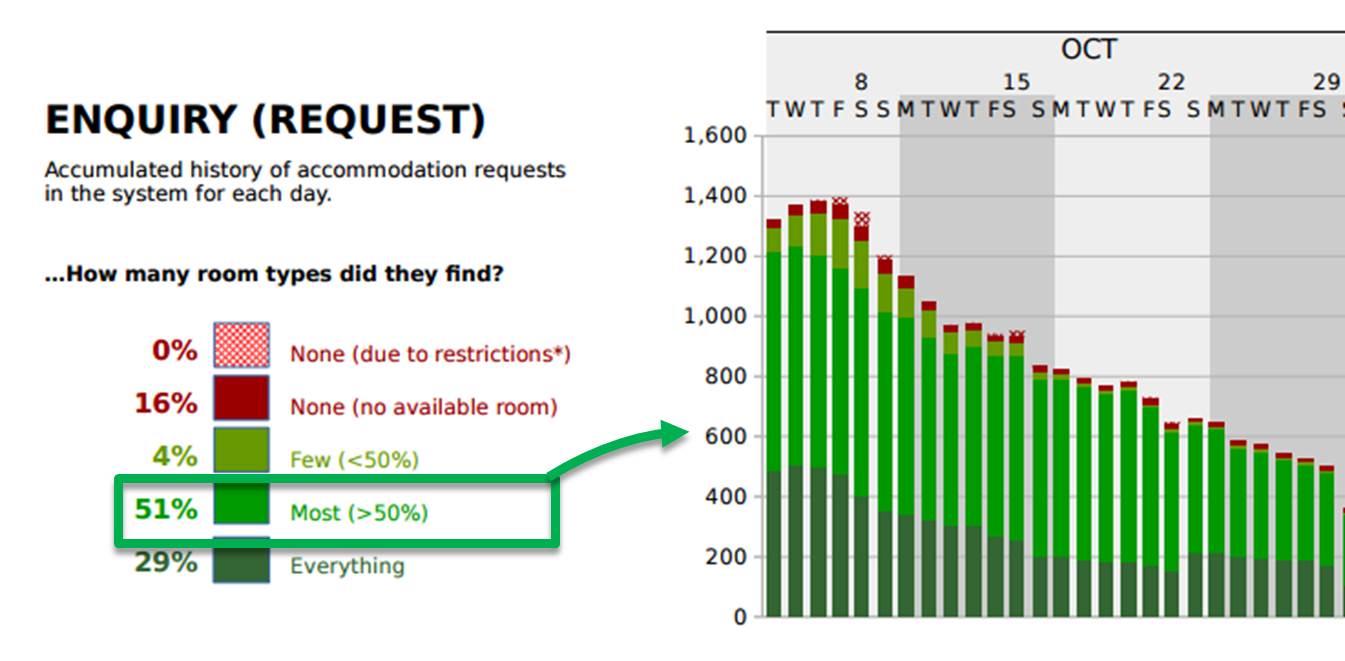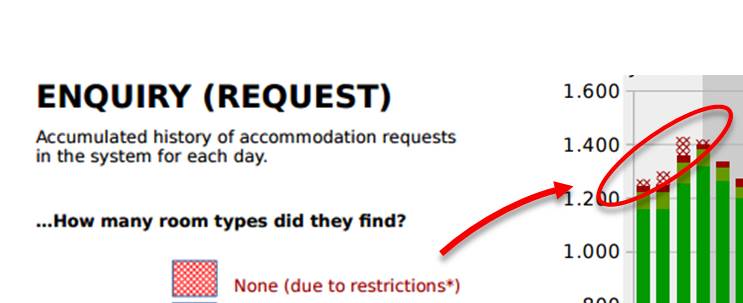With a record occupancy rate in many hotels and destinations, this year comes with a new problem: filling the hotel too soon.
In order to explain this occurrence, at Mirai we provide our hotel clients with a new report that analyses this problem. In this article, we analyse different aspects which derive from it that are helpful in order to improve our stock management.
Being full is positive, ALTHOUGH…
Does your hotel fill up quickly and often? If this is the case, on one hand it’s a reason to be happy but, on the other, it’s a symptom that you’re not optimising your stock and rates properly. You will have missed out on potential clients, some of whom would have been ready to pay more for their rooms than the ones who have already booked.
At Mirai, it has come as a surprise to us to find a large quantity of client hotels that have a lot of fully-booked future dates:
If I’m already fully booked, is it too late to do anything about it?
You may find out that you are fully booked for future dates. This doesn’t leave you with a lot of room for manoeuvre. If you’re full, there’s not a lot you can do. You’re too late. The ideal scenario would have been to prevent this from the start. However, you can take some positives from this practical utility:
- Learn from this for the future. Don’t make the same mistakes on equivalent future dates or next year.
- If you get cancellations (and you don’t have overbooking), when you reinstate availability you have a second chance to sell your last available rooms properly: squeeze the price and place them only on your most profitable channels.
- In the upcoming months, remember that the production of your direct sales could have been larger. A report that predicts it is already telling you. When you get the closed-production numbers, remember that they told you it could have been more.
The ideal situation: have the least amount of red days (sold-out days) and, nevertheless, end up fully booked.
Anticipate in time when there will be high demand and hold the high price for the maximum number of available rooms until the last minute.
At Mirai, we have realised that we admire hotels and chains that are capable of anticipating high demand, establishing a high price from the beginning, looking like they’re not going to be full and ending up with high occupancy figures at a higher price.
Why do hoteliers prefer filling up quickly?
- Less risk: Waiting until the last minute with available rooms at a high price is a risk. They may end up not being sold if there are no bookings that fully book the hotel a few days before each date.
- Less work: When a future date is completely sold out, that date is closed and we stop worrying about it. The sooner we can be free of controlling it, the better it is… apparently.
- Nobody will ask for explanations. Not filling the hotel is a statistic that stands out above the rest. You can’t hide it. Your occupancy percentage, a standard indicative figure for hotels, will reveal it. However, nobody will realise if you fill the hotel too quickly. This figure is not measured or exposed or known. On the contrary: the only thing that will be revealed is that you filled the hotel, something which is seemingly positive.
Requirement: Knowing your capacity to receive demand on short notice
Committing to always maintaining availability open requires expertise and deep knowledge of your demand’s behaviour.
You need to know and measure your capacity in order to receive bookings on short notice. Depending on whether it’s higher or lower, you can apply the strategy of holding onto a high rate with more or less security.
- Urban-business hotels usually have shorter booking window than holiday hotels.
- Online channels have less booking window than traditional or package channels.
- A higher composition of national clients or clients from nearby nations ensures a higher volume of last-minute bookings.
- How does the composition act on this subject? If they fill up quickly, you have a chance: if you hold on, you are alone to gather the whole demand. Hotels that fill up too quickly, by definition, do not know what their last-minute pick-up is. Because they never wait to fill up, they never know what they’re missing out on. They never receive the figure. Our report will unveil it.
If I’m not full, why do red sections appear?
It might seem strange to you that all of your future dates constantly show searches without availability. The reason is that you either closed that date temporarily or rather, more likely, made the initial charge too late and your early searches found no availability. For this reason, at Mirai we recommend that your hotel is always charged, at least, a year in advance and we remind you of this during these dates. Here is the reason behind our insistence.

Control “partial” availability
Not everything is about having availability or being full since everything is not black or white. There is an intermediate range in which some room types are no longer available. The usual scenario is that only the suite or a similar room type is available. If you do not take these scenarios of lack of partial availability into account, measurements would be incomplete.
Inconveniences regarding lack of availability start to take place when some room types are no longer available or when some requests cannot be met (e.g. only single rooms are available). The negative impact happens from the first partial closure and, above all, when you can no longer meet requests for certain occupancies, especially regular ones (you don’t have any more double rooms).
Our report gather this figure, in a different green tone.

The practical utility would be for availability, like the price, to be a figure that is controlled and measured by room type.
Novelty: Clients who are left out because of your restrictions
If you require minimum stays, you leave clients out. If this is deliberate and controlled, it may be a good filter if you have high demand. However, our experience tells us that many hoteliers do not use these restrictions appropriately. In order to measure its impact, our report gathers the amount of requests that could not be met due to not having complied with restrictions despite having availability. For the user, in practice, the consequence is the same: you cannot meet his request: he cannot stay at your hotel.

Managing your availability correctly is essential in order to optimise hotel income. Applied to direct sales, it is also a chance to gain market share on intermediaries. To achieve this, the first step is measuring the problem.




